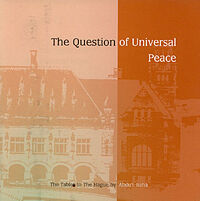Tablet to The Hague

The Tablet to The Hague is a letter which ‘Abdu’l-Bahá wrote to the Central Organisation for Durable Peace in The Hague, The Netherlands on December 17, 1919.
Subject[edit]
In the tablet, ‘Abdu’l-Bahá gives an overview of Bahá’í principles, which include the following:
- Declaration of universal peace.
- Independent investigation of reality.
- Oneness of humanity.
- Religion must be the cause of fellowship and love.
- Religion must be in conformity with science and reason.
- Abandonment of religious, racial, political, economic and patriotic prejudices.
- One universal language.
- Equality of women and men.
- Voluntary sharing one's property.
- Man's freedom from the captivity of the world of nature.
- Religion is the ideal safeguard.
- Material civilization should be combined with Divine civilization.
- Promotion of education.
- Justice and right.
He declares that the League of Nations is "incapable of establishing universal peace", and calls for the establishment of a Supreme Tribunal, representing all countries:
| “ | When the Supreme Tribunal gives a ruling on any international question, either unanimously or by majority rule, there will no longer be any pretext for the plaintiff or ground of objection for the defendant. In case any of the governments or nations, in the execution of the irrefutable decision of the Supreme Tribunal, be negligent or dilatory, the rest of the nations will rise up against it, because all the governments and nations of the world are the supporters of this Supreme Tribunal. | ” |
History[edit]
In 1915 three Bahá'ís, one of whom was Ahmad Yazdání, wrote a paper on Bahá'í principles which was submitted to the Central Organization for a Durable Peace. The Organization sent a letter in reply for ‘Abdu’l-Bahá to Ahmad which he was unable to deliver until the close of WWI. In 1919 ‘Abdu’l-Bahá revealed the Tablet to the Hague and summoned Ahmad to the Holy Land so that he could deliver it.[1]
The Tablet was delivered to the Hague in person by Ahmad Yazdání and Hand of the Cause Ibn-i-Asdaq in 1920.[2] It was published in English in a pamphlet under the title Letter and Tablet to the Central Organization for a Durable Peace: The Hague by the Bahá'í Publishing Society in Chicago the same year.[3] It was translated by Shoghi Effendi.[4]
Notes[edit]
- ↑ The Bahá’í World, An International Record. (1981). Bahá’í World Centre. Haifa. Volume 17 (1976-1979), Pg(s) 438-439. View as PDF.
- ↑ Balyuzi 1985, p. 176.
- ↑ The Bahá’í World, An International Record. (1933). National Spiritual Assembly of the Bahá’ís of the United States and Canada. New York City, NY. Volume 4 (1930-1932), Pg(s) 287. View as PDF.
- ↑ The Bahá’í World, An International Record. (1986). Bahá’í World Centre. Haifa. Volume 18 (1979-1983), Pg(s) 837. View as PDF.
References[edit]
- ‘Abdu’l-Bahá (2024). Tablets to The Hague (1919-1920). Bahá’í Reference Library.
- ‘Abdu’l-Bahá (1999) [1919]. The Question of Universal Peace - The Tablet to The Hague by ‘Abdu’l-Bahá. Den Haag, The Netherlands: Stichting Bahá'í Literatuur. ISBN 9070765438.
- ‘Abdu’l-Bahá (July 1920). "Second Tablet to the Committee of Universal Peace at The Hague". Star of West. 11 (17): 288.
- Balyuzi, H.M. (1985). Eminent Bahá'ís in the time of Bahá'u'lláh. Oxford, UK: George Ronald. ISBN 0853981523.